Origins of the New Testament
A while back I did a Bible study on the origins of the New Testament and so I thought I would post some of that here as a brief introduction for those who haven’t had any background before. I think the Christmas season is a good time for something like this.
VERY brief time-line (approximate dates):
•AD 30: Jesus is crucified.
•AD 51: 1 Thessalonians Written - the first of Paul’s epistles
•AD 67: Paul is martyred.
•AD 68-70: Gospel of Mark written (most likely to be the first Gospel written).
•AD 110 (although some say as late as AD 140): 2 Peter written - the last book in the NT canon to be written
Textual Witnesses:
There have been no autographs (originals) of any of the New Testament books found so the Word must be based on copies. Not all copies are made equal. Both age and location of the copies (or “witnesses”) found are factored in to their “quality”. These “Text-Types” and their relative autorities are more intelligently discussed elsewhere, so I will just say that the Alexandrian text-type are genearlly considered more authoratative and accurate. The following are types of witnesses found with the oldest (which are often given the most weight) first:
Papyri: (Indicated by a script P) These are the oldest sources made from plants and written in the II-VII centuries. 116 different papyri have been found. P52 seems to be the oldest from around 125-150AD (John 18, size of credit card). P46 being one of the more important finds which included all of Paul (less pastorals) and Hebrews from around 200AD: this work showed that even at that early time, Paul was being circulated. Some are individual pages, some are scrolls or codices (books). A 1 page papyrus cost about a day’s wage.
Uncials: IV-IX centuries. 300 have been found. Written in all capitals with no spaces between words. Written on newer parchment or vellum surfaces (often animal skin). א, A, B (Codex Vaticanus - 4th Century), C, and Θ being the most reliable and complete.
Lectionaries: X century onward. 2100 have been found. These are usually larger collections of scriptures. Many are translations from the Greek into other languages. One of the most notable is Jerome’s Latin Vulgate – 383AD.
Versions: Other language versions from II century onward. Syriac, Latin, Coptic, etc. 7 found.
Church Fathers: II century onward. Church fathers who have copied various scriptures.
Variant Readings
There have been over 6000 of these manuscripts found (NOTE: I think it is important to point out here that this is vastly more witnesses than any other ancient work.). Within these 6000 manuscripts, variant readings - disagreements from one version to another - creep in: some 150-250,000 of them! There are two different kinds of variants: intentional and unintentional. Intentional alterations: scribes trying to improve grammar, spelling, theology, reducing tough readings, harmonizing of the gospels. Unintentional errors: skipping a line, writing a line twice, mistaking similar letters, aural errors. How do we read GODISNOWHERE: “God is now here” or “God is nowhere”?
Criteria for NT Textual Criticism
How do we decide which variant is more original and correct? This is what textual criticism is all about. There is a tendency to prefer older versions that the newer (but not necessarily the case). External Criteria: Judging the “originality” of variant readings based on the quality of the NT manuscripts date of manuscripts, usually P or early Unicial codices. Scholars tend to prefer texts that come from the Alexandrian family. (King James was from the Eastern) The Western family also tends to be earlier and more reliable than the Eastern. Internal Criteria: judging the “originality” of variant readings based on…
•Lectio Difficilior – usually the rougher reading is earlier and more original.
•Lectio Brevior – usually the shorter reading is preferred. Scribes will conflate or explain.
•Non-harmonistic reading. Scribes had strong tendency to read the wording of one Gospel into another.
•Stylistic agreement – Koine vs Attic Greek reading. Style should be consistent with an author.
These criteria don’t always all have to be there and don’t necessarily mean much on their own, but when put together they can usually make a strong case for a particular reading.
A Few Notes on Variants
There are many that get worried about variants or differences in the text. But one of the most amazing things about all this is that none of these differences cause problems for primary theology. There was great care taken in the preservation of these manuscripts – most areas are in agreement - epsecially when it comes to foundational theology. 6000 manuscripts attest to the importance of the Word – doctrine does not change by these variant readings. There is absolutely no other writing that comes close to the witness of the Bible. Thanks be to God! A look at a specific variant (Luke 2.43) can be found at the bottom of this post.
A few images some found manuscripts (click for larger version):

I hope this has made sense and has introduced you to the complexity that goes into determining the Greek New Testament! Let me know if you have any questions or just want to know more!
Resources
Bryan’s Biblical Links: A great page of links for further study.
Early Greek Bible Manuscripts Project: lots of info on the earliest sources.
Guide to Early Church Documents
A Journal of Biblical Textual Criticism
The Textual History of the Books of the New Testament
Bible-Links Page: Papyri - wide variety of other information is available here as well
Merry Christmas!
-Matt Jones
Variant example from Luke:
This variant reading from Luke 2.43 is probably an intentional scribal error to “correct” or “clear up” doctrine.
41 Now His parents went to Jerusalem every year at the Feast of the Passover.
42 And when He became twelve, they went up there according to the custom of the Feast;
43 and as they were returning, after spending the full number of days, the boy Jesus stayed behind in Jerusalem. But His parents were unaware of it,
44 but supposed Him to be in the caravan, and went a day’s journey; and they began looking for Him among their relatives and acquaintances.
Verse 43:
καὶ τελειωσάντων τὰς ἡμέρας, ἐν τῷ ὑποστρέφειν αὐτοὺς ὑπέμεινεν Ἰησοῦς ὁ παῖς ἐν Ἰερουσαλήμ, καὶ οὐκ ἔγνωσαν οἱ γονεῖς (“knew the parents”) αὐτοῦ.
NA27 (Nestle-Aland 27th Edition - let me know if you want to know more about this) shows that the textual reading is supported by א, B, D, L, W, f1, etc. The variant reading is also shown: “knew Joseph and the mother” and is supported by A, C, Ψ, f13, M, etc. All the “א, B, D, L, W, f1″ stuff probably won’t make sense - the just of it is that different manuscripts will support a different reading.
Which is correct (better?)? Must look at dates, locations, and reasons the variant could have crept in. Seems that the reading of the variant is not is strong because of location and date. Its introduction can also be explained because of a intentional scribal error: the scribe wanted to clear up doctrine so that the Virgin Birth was not as ambiguous. So it is easy to explain why “parents” was changed to “Joseph and (his) mother”. It would be difficult to explain why “Joseph and (his) mother” was changed to “parents”. We can also look to Metzger’s A Textual Commentary on the Greek New Testament for his suggestions.
Does that make sense?




Very educational. There is so much of the Bible I want to better inform myself of and learn about….
Thans, hope it helps out a bit, just let me know if you want to know anything else. There is definitely a lot the Bible has to offer!
It’s interesting that you accept a more traditional dating for Mark before the destruction of Jerusalem, which most mainstream scholars won’t do, but then you adopt the late dating of II Peter that very few evangelicals will tolerate, given that Peter died in the 60s and that II Peter does claim to be by Peter. I realize that there’s no real inconsistency in accepting these dates, but it’s a strange combination.
Heh, well like I said, the dates are approximate. I haven’t really made any personal decisions as to what dates I hold to. I just haven’t been too concerned with that in my own personal study… I suppose some day I will look more into it. Thanks for pointing that out though!
I have written two books which tell a new tale concerning Jesus of Nazareth. The first book, “Judas the Galilean”, [Matt has removed this section] The second book, “New Testament Lies”, [Matt has removed this section] [and this section] If you have any questions concerning this hypothesis, please do not hesitate to call or e-mail me. Thank you for your time. Daniel T Unterbrink [and this section]
Dan I removed about 95% of your post because this is not a place for free advertisement of your crackpot ideas. You are perfectly free to believe whatever you want, but this is a place for comments about this post and not for you to post your essays and writings just because you think they match with this post.